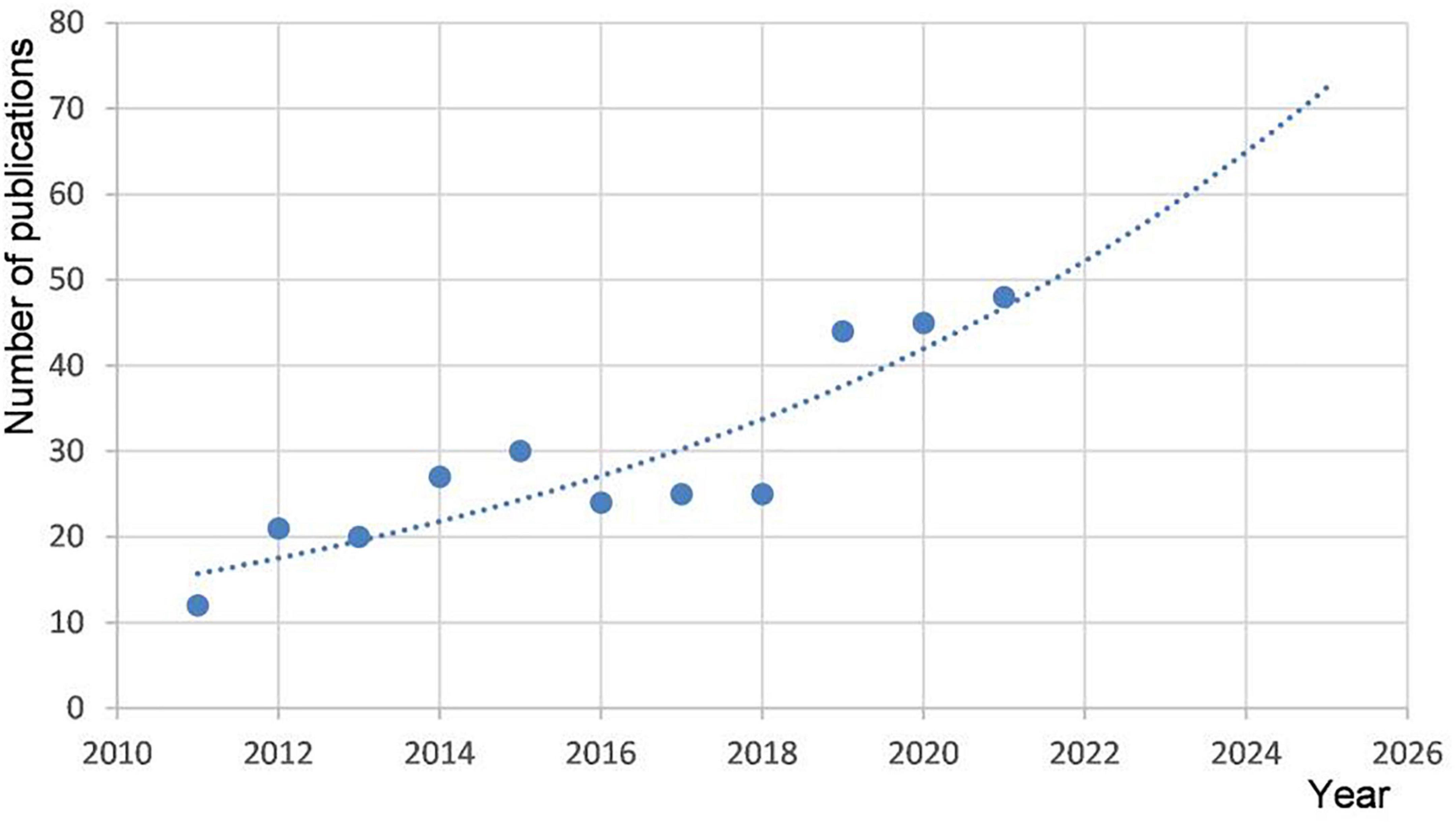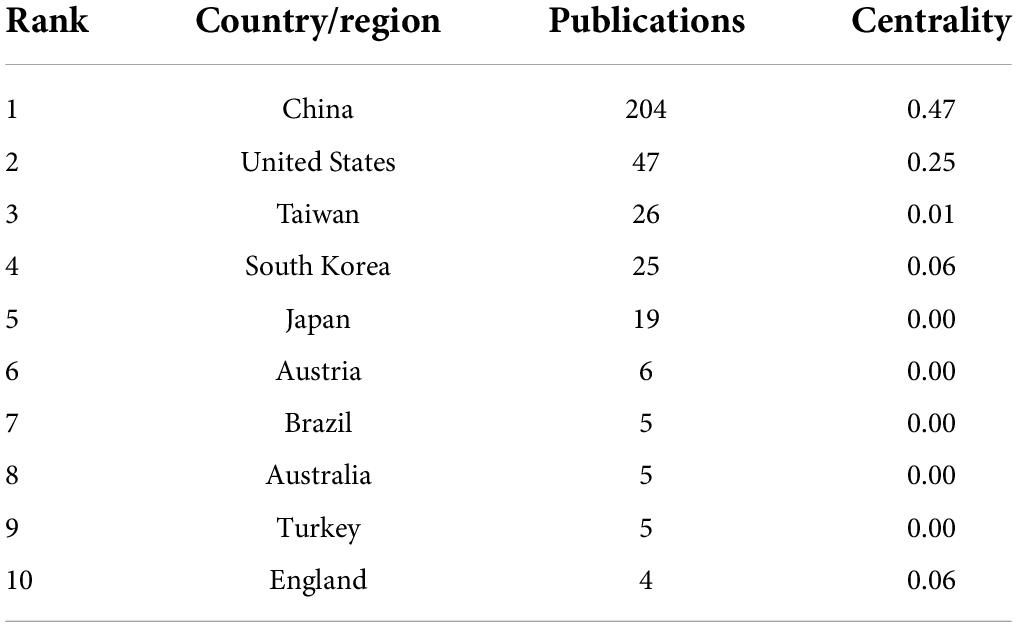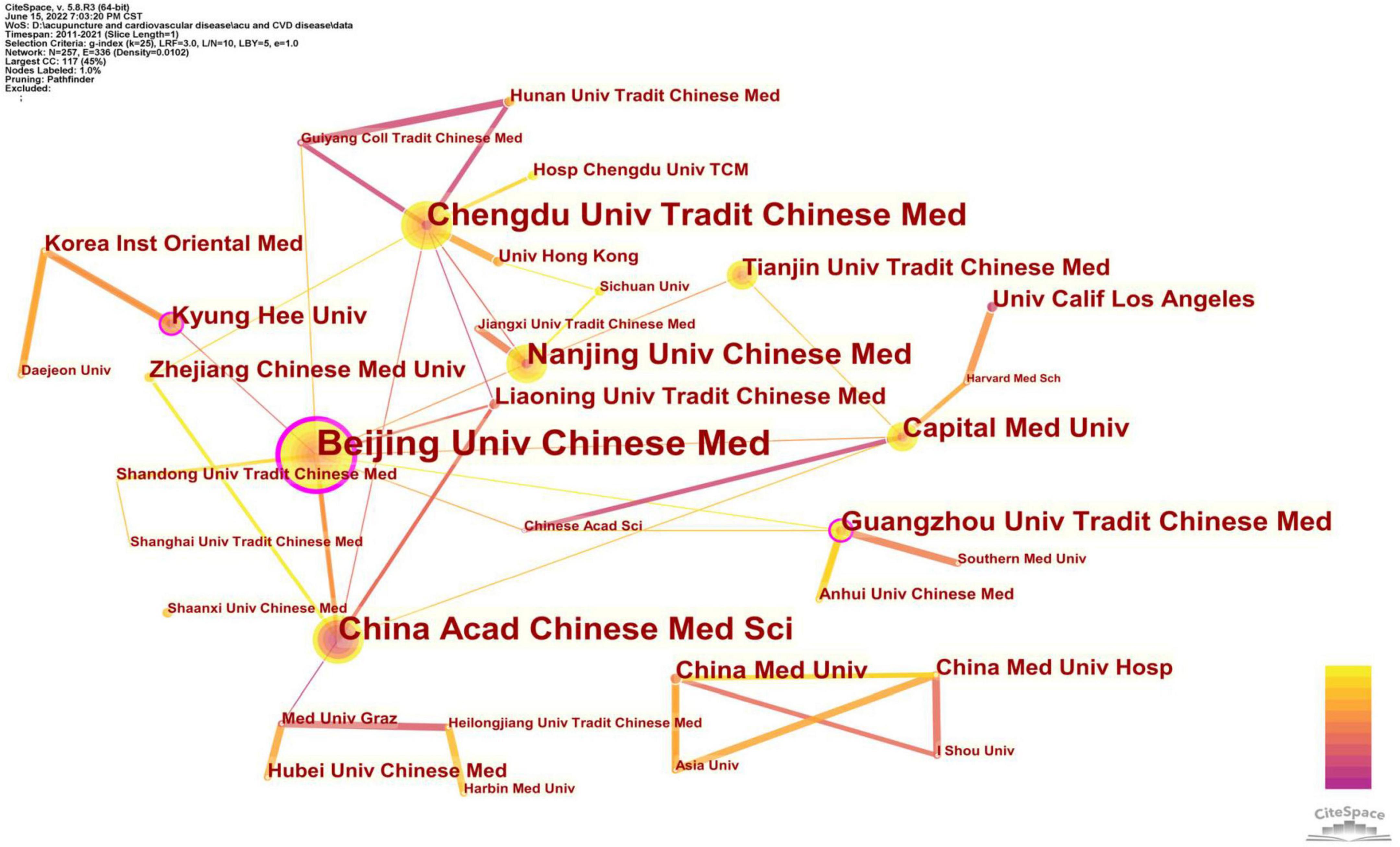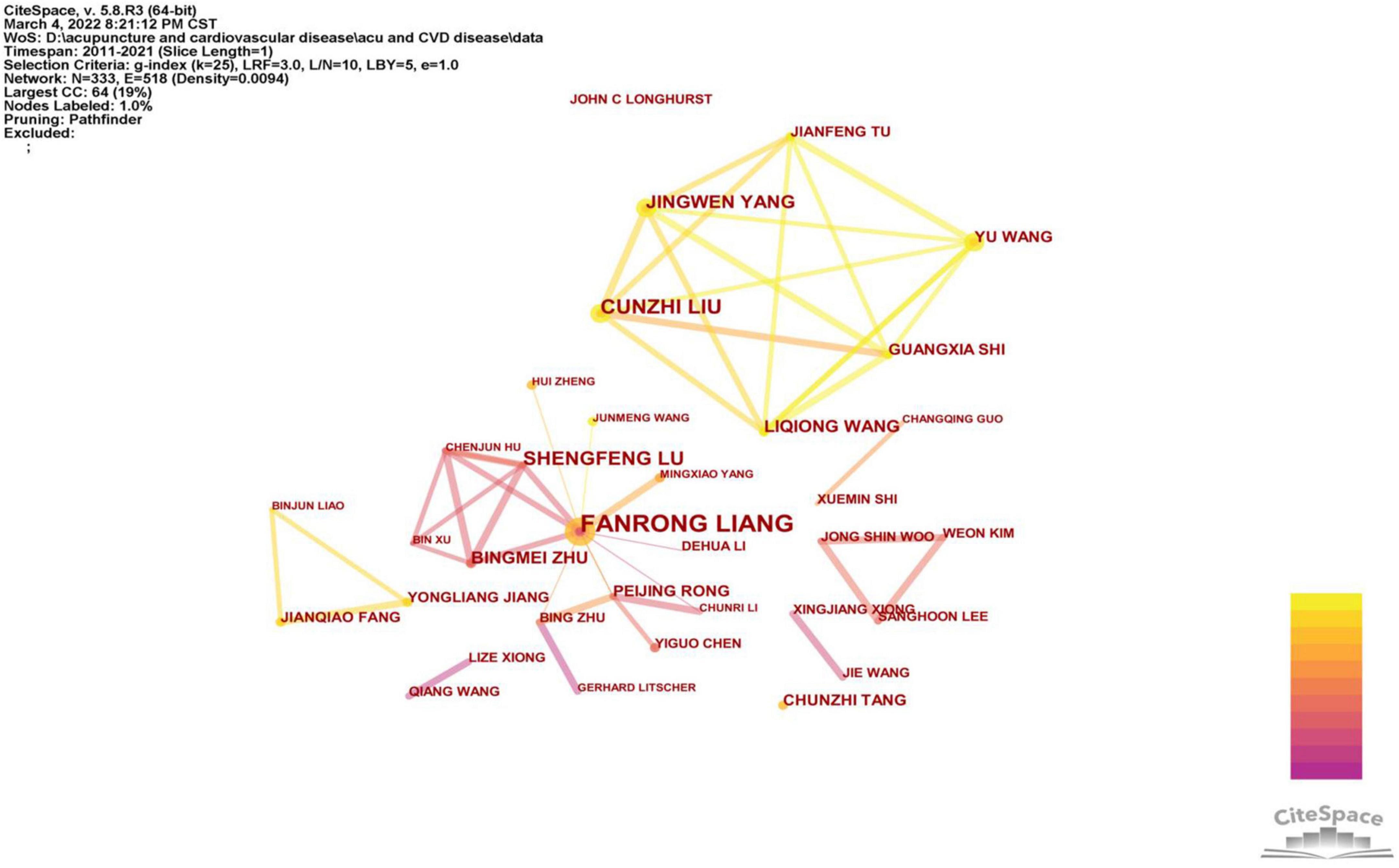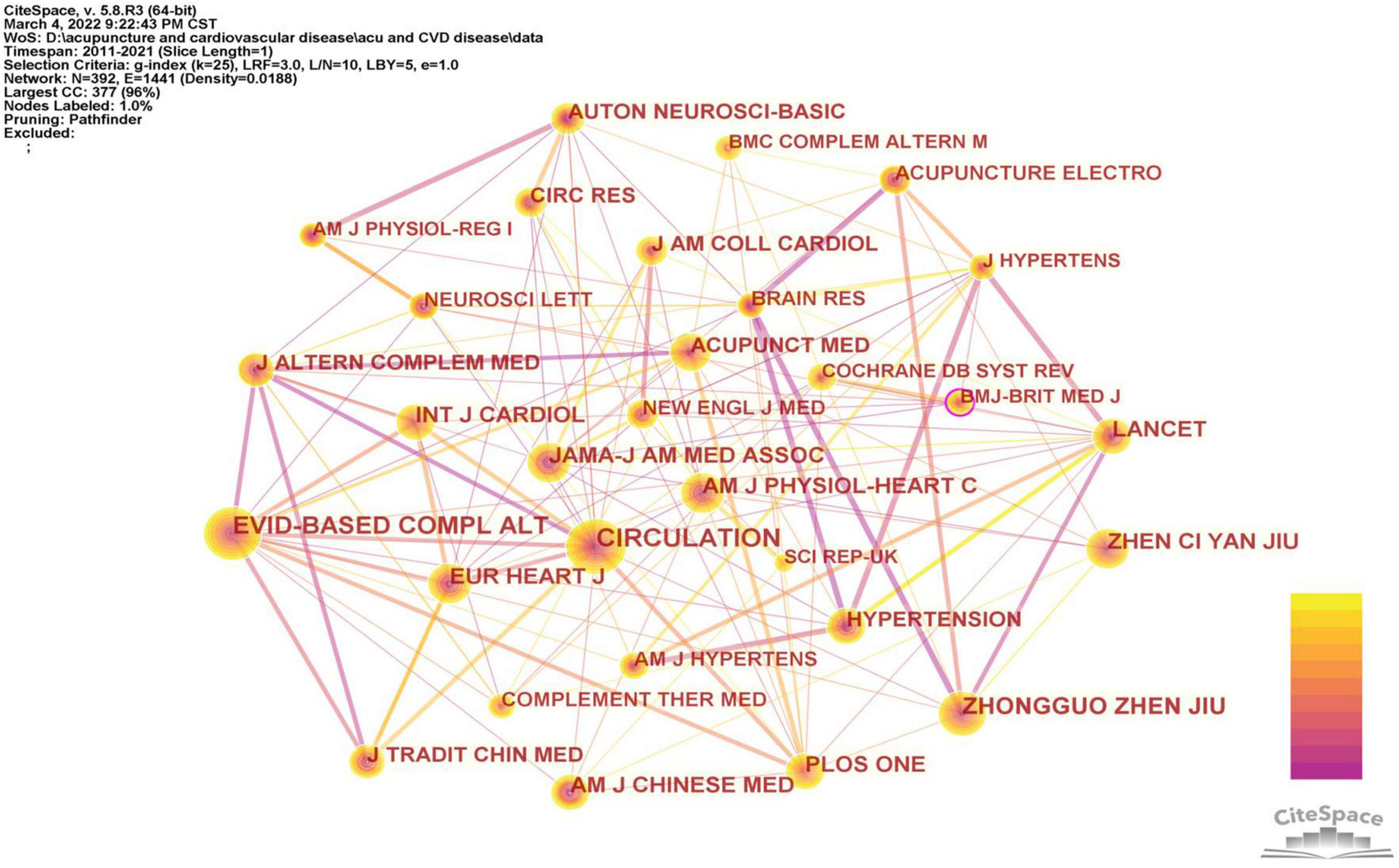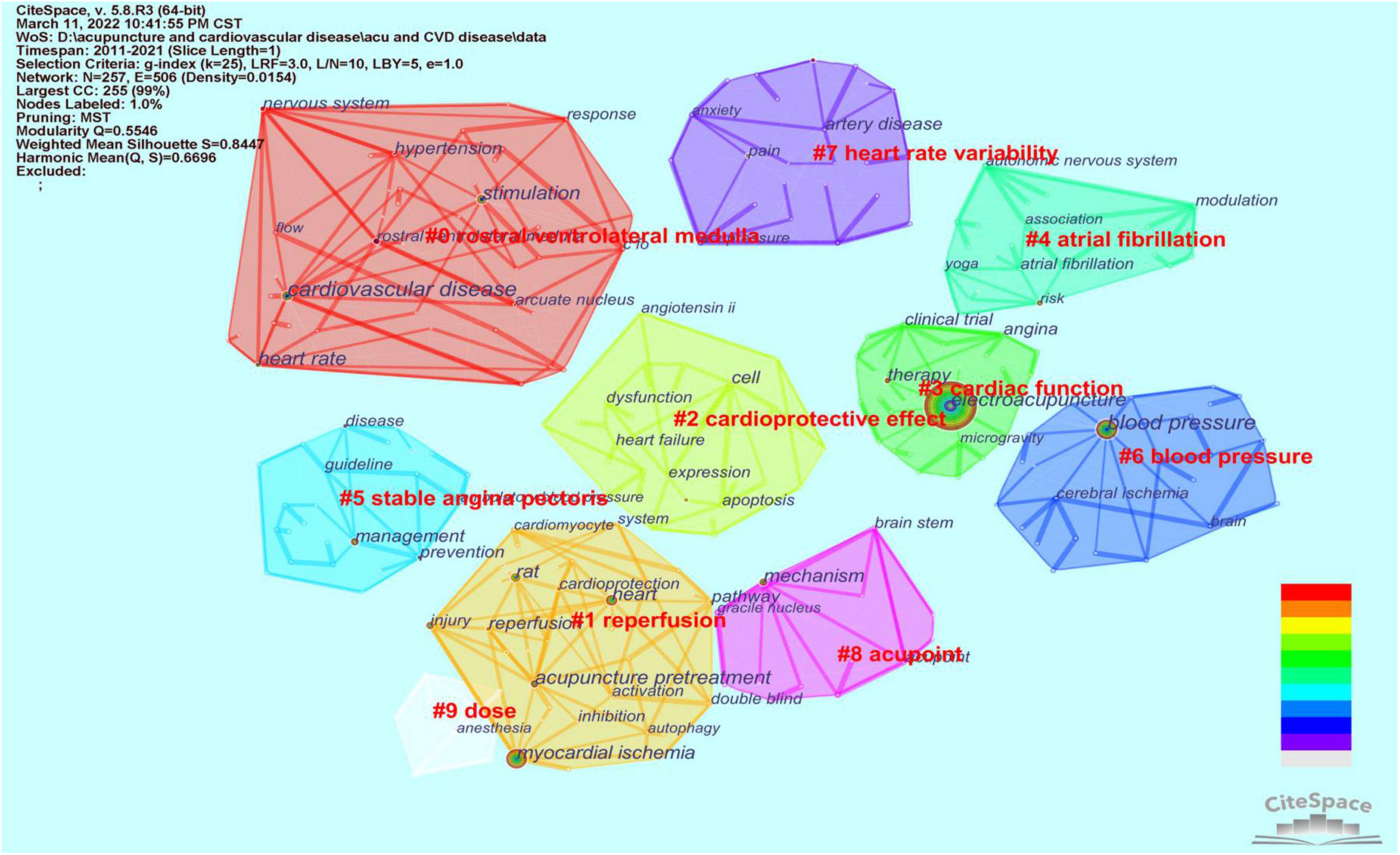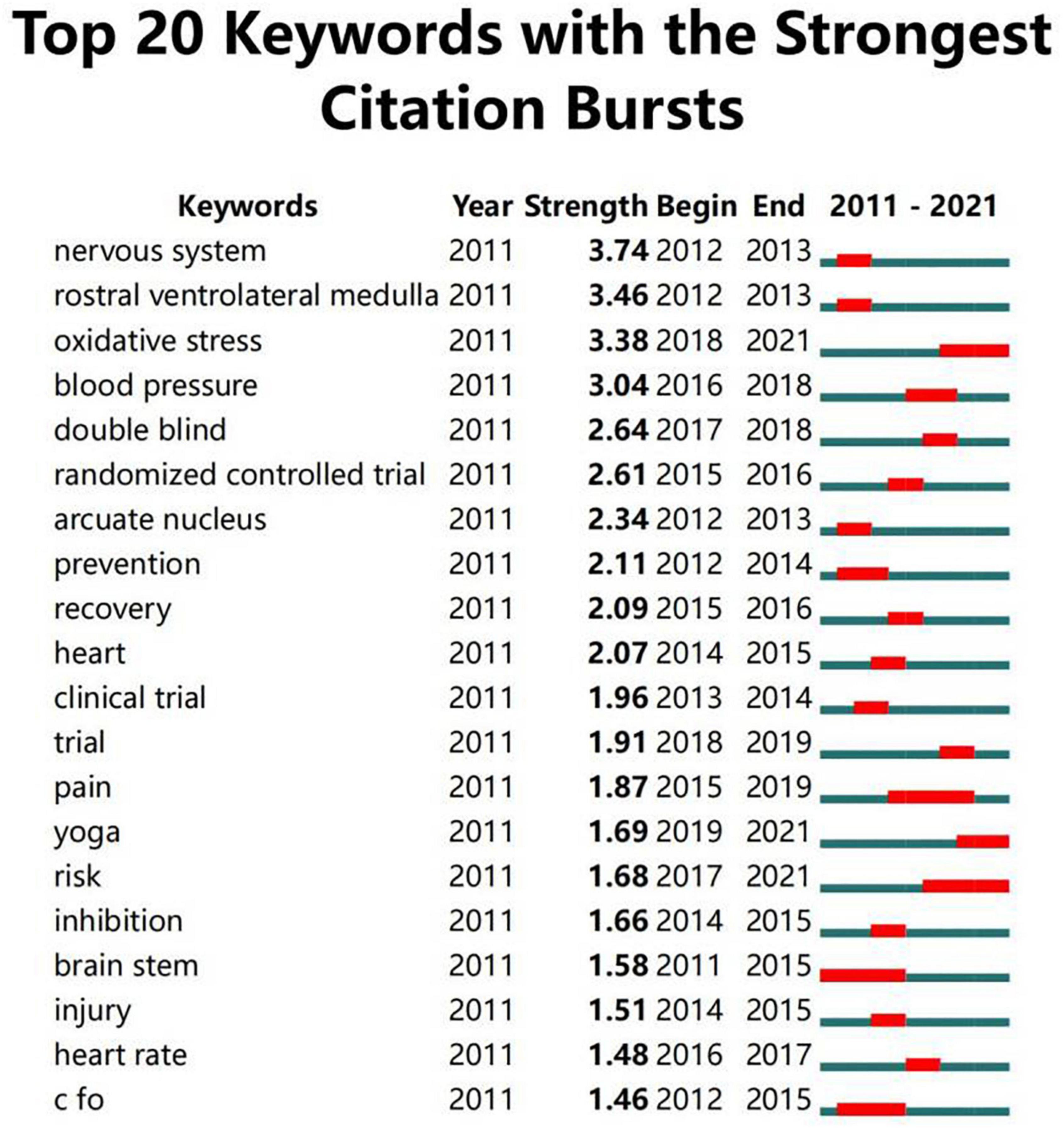- 1School of Acu-Mox and Tuina/The Third Teaching Hospital, Chengdu University of Traditional Chinese Medicine, Chengdu, Sichuan, China
- 2Acupuncture and Tuina School/The Third Teaching Hospital, Chengdu University of Traditional Chinese Medicine/Clinical Research Center for Acupuncture and Moxibustion in Sichuan Province, Chengdu, Sichuan, China
Background: With high morbidity and mortality, cardiopathy is a major component of cardiovascular disease, causing a huge burden of disease to public health worldwide. In recent years, research on acupuncture treatment of cardiopathies has been increasing. However, no bibliometric analysis has been conducted to systematically describe the research progress and hotspots in this field. Therefore, this study aimed to conduct a bibliometric analysis of the relevant literature to explore the current status and future development of acupuncture for cardiopathies.
Methods: The Web of Science (WoS) Core Collection Database was searched for literature related to acupuncture therapies for cardiopathies from 2011 to 2021. Using CiteSpace 5.8 R3, cooperation network diagrams of authors, institutions, countries and journals, keyword co-occurrences, and clustering were performed and analyzed.
Results: A total of 321 studies were included. Overall, the number of annual publications increased yearly. These publications came from 31 countries or regions, of which China and the United States made the greatest contributions. In total, 333 authors from 258 institutions participated in this field, and Beijing University of Chinese Medicine and Professor Fanrong Liang were the most published institution and author, respectively. Evidence-based Complementary and Alternative Medicine published the largest number of articles, and CIRCULATION was the most commonly cited journal. Based on co-occurrences and cluster analysis of 257 keywords, three research frontiers and hotspots were identified: acupuncture for blood pressure regulation, acupuncture for coronary heart disease, and acupuncture for regulation of heart rate. In these three research frontiers, the rostral ventrolateral medulla (RVLM) and autonomic nervous system (ANS) are the most popular mechanisms.
Conclusion: A stable development trend has formed in this field. Further research should focus on the role of acupuncture therapies in the treatment of hypertension or hypertensive heart disease, coronary heart disease, and arrhythmia based on the mechanisms related to the RVLM and ANS.
Introduction
Cardiovascular disease is the leading contributor to the burden of disease worldwide. With population growth and aging, the number of cardiovascular diseases worldwide has almost doubled from 271 million in 1990 to 523 million in 2019 (1). As a major branch of cardiovascular disease, heart disease includes congenital heart disease, hypertensive heart disease, pulmonary heart disease, coronary heart disease, arrhythmia, cardiomyopathy, pericardial disease, and heart valve disease. Most of these diseases are characterized by acute onset, such as coronary heart disease, which often manifests as sudden cardiac arrest or even sudden cardiac death (2). Sudden cardiac death (SCD) has led to approximately 230∼350 thousand deaths per year in the United States over the past 20∼30 years (3). During 2016 in China, the age-standardized prevalence rate of ischemic heart disease was 15.07‰, while that of atrial fibrillation and flutter was 6.05‰, and that of hypertensive heart disease was 3.22‰ (4). There were 40.7 cardiac deaths in China per 100,000 person-years from 1980 to 2016 (5). These gloomy statistics represent a huge challenge for the world.
As a treasure in traditional Chinese medicine, acupuncture has become one of the most widely accepted alternative medicine methods worldwide. Disease spectrum analysis of 2,471 systematic evaluations of acupuncture therapy from 2000 to 2020 in the Web of Science (WoS) database showed that acupuncture therapy covers 77 kinds of illnesses in 12 fields (6), indicating that acupuncture therapy has broad spectrum characteristics. In recent years, the mechanism of acupuncture in analgesia, anti-inflammation, and nerve regulation has been the subject of abundant mechanistic research (7–9), which provides a theoretical basis for research related to acupuncture therapies and cardiopathies.
CiteSpace is a software for visual analysis of literature to understand the past and present development of relevant fields and to identify the most active research frontiers and development trends. CiteSpace, which stands for “citation space,” is a citation visualization software that focuses on the investigation of potential knowledge contained in scientific analysis and was gradually developed against the background of scientometrics and data visualization. Because the structure, law, and distribution of scientific knowledge are presented through visualization, the visualization graph obtained through the examination of such methods is also called the “scientific knowledge map.” Cooperative network analysis, co-occurrence analysis, and co-citation analysis of the original literature can be performed based on the Java development environment. Recently, bibliometric analyses of acupuncture and obstetrical and gynecological diseases (10), migraine (11), insomnia (12), knee osteoarthritis (13), and cancer (14) have been reported, revealing the research progress and frontiers of acupuncture and related diseases. However, no report concerning the application of acupuncture in the treatment of cardiopathies based on bibliometric analysis has been found.
Therefore, in the present study, we aimed to explore the frontiers and development trends of acupuncture for cardiopathies based on co-occurrence network diagrams of authors, academic institutions, countries and scientific journals, keyword co-occurrences, and clustering over the past 10 years via CiteSpace.
Methods
Data collection
We extracted literature from the SCI-EXPANDED database in the WoS Core Collection via the Chengdu University of Traditional Chinese Medicine Library’s website. The search strategy (Table 1) included the topics “acupuncture therapy” and “cardiopathy” from January 1, 2011 to December 31, 2021, and we downloaded all data within 1 day on February 15, 2022. There was no restriction on language, and we retrieved 801 studies. After eliminating meeting abstracts (14), editorial material (18), book chapters (3), letters (11), corrections (1) and articles not related to the search topic (433), we included 321 records (see the Supplementary Material), including 255 articles and 66 reviews, for further visualization and analysis. We saved these papers in a text document and named it “download_txt.”
Data analysis
We employed CiteSpace 5.8.R3, which contains a bibliometric technique to describe the characteristics of the included literature. First, we constructed cooperation network diagrams of authors, academic institutions, countries and scientific journals to describe individual contributions and cooperation among these entities. In addition, we performed keyword co-occurrence analysis, keyword clustering analysis, and citation burst analysis to identify research directions and hotspots. The software parameters were as follows: (1) time slicing: from January 2011 to December 2021, the number of years per slice was 1; (2) each node type was selected at a time; (3) selection criteria: g-index: k = 25; and (4) pruning: pathfinder or minimum spanning tree. The g-index measures the research achievements of an independent individual or unit. In CiteSpace, on the basis of increasing the scale Factor k, we used a modified g-index algorithm to rank and extract a specific number of independent individuals or units. The “pruning” algorithm is employed to simplify lines in a network to reduce the network’s density and improve its readability. “Pathfinder” and “minimum spanning tree” are the most commonly used network clipping methods in CiteSpace (15).
The visualization maps consisted of tree rings and lines connecting the tree rings. Each tree ring (node) represents a unit (e.g., an author, a country or region, a journal), and the links represent the cooperation or co-occurrence between them. A larger tree ring denotes more publications or a larger frequency of occurrence of the unit, and thicker lines indicate more cooperation or co-occurrence between them. The color of the tree rings and lines provides a perspective of evolution over time, in which a shift in tone from cool to warm signals the time from far to near. Meanwhile, CiteSpace uses “betweenness centrality” to describe the umbilical role of a node and marks it with a purple ring.
Results
Annual publication outputs and time trend
Since 12 articles emerged in 2011, the number of studies published on this topic rose with fluctuations. From 2016 to 2018, the number of articles declined, but by a small margin. In 2019, the annual publication output rose significantly, and in 2021, the output increased continuously (Figure 1). The time curve suggests a trend of steady growth in the number of publications in the near future.
Distribution of countries/regions
We used CiteSpace to visualize the numbers of articles published in each country or region about acupuncture therapy for the treatment of cardiopathies. The map of country/region distribution consisted of 31 nodes and 56 links, indicating that 31 countries or regions have made contributions to the research on acupuncture therapy for cardiopathies (Figure 2). The People’s Republic of China (PRC) was number 1 with an absolute advantage (204 publications), followed by the United States (47 publications), Taiwan (26 publications), South Korea (25 publications), and Japan (19 publications). The top two countries in terms of centrality were China (0.47) and the United States (0.25), and other countries or regions were less than 0.10 (Table 2). This finding suggests that China and the United States play crucial roles in research in this field, and they have both formed their own networks of international cooperation. However, the thin line between China and the United States implies that the academic exchanges between the two countries are not rich enough.
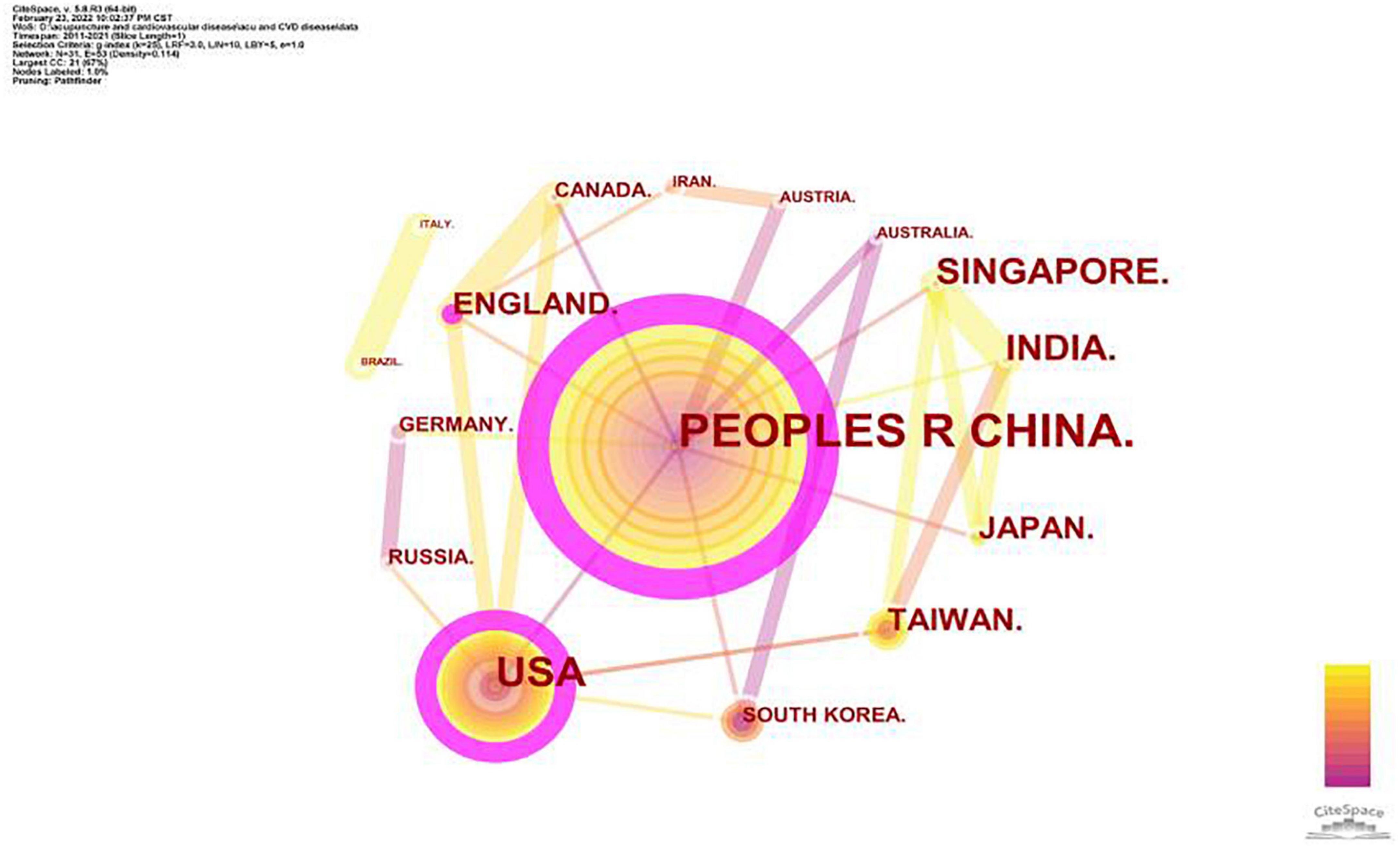
Figure 2. Network map of co-authorship between countries or regions about acupuncture on cardiopathy.
Distribution of institutions
We performed the co-occurrence analysis of institutions using CiteSpace, resulting in 258 nodes and 333 links, which means that 258 institutions have participated in research on acupuncture and cardiopathy (Figure 3). The top ten institutions were Beijing University of Chinese Medicine (39), Chengdu University of Traditional Chinese Medicine (28), China Academy of Chinese Medical Sciences (26), Nanjing University of Chinese Medicine (20), Guangzhou University of Chinese Medicine (17), Capital Medical University (16), University of California System (14), China Medical University (14), Kyung Hee University (13), and Tianjin University of Traditional Chinese Medicine (13). For centrality, the top three institutions were Beijing University of Chinese Medicine (0.15), Kyung Hee University (0.11), and Guangzhou University of Chinese Medicine (0.11), while the others were no more than 0.10 (Table 3). The high centrality nodes are marked by purple circles in the mapping. Eight of the top institutions with the highest publication numbers came from China, which is consistent with the analysis of national contributions.
Authors and co-cited authors
A total of 333 authors have taken part in research on acupuncture in relation to cardiopathies (Figure 4). Fanrong Liang from Chengdu University of Traditional Chinese Medicine ranked first with 21 publications, followed by Cunzhi Liu (12), Shengfeng Lu (12), Yu Wang (12), Jingwen Yang (11), Guangxia Shi (9), Liqiong Wang (7), Bingmei Zhu (7), Peijing Rong (7), and Chunzhi Tang (6). A noteworthy feature of this outcome is that the centrality of the authors was relatively low (less than 0.10), indicating that these authors have not established a close and influential cooperative network (Table 4A). Five of the top ten authors come from Beijing University of Chinese Medicine, and all top ten authors come from China. These results echo the analysis of the contributions of countries and institutions.
Among the 418 co-cited authors (Figure 5), three were cited more than 50 times. The top ten co-cited authors are shown in Table 4B. Li Peng from the University of California (Irvine) ranked first, with 74 citations, followed by Zhou Wei (62), Flachskampf FA (50), Tjen-A-Looi SC (36), Gao Junhong (35), Wang Jie (34), Li Jing (34), Zhao Ling (33), Kearney PM (32), and Lee H (32). Nine of the top ten co-cited authors came from the United States and China, indicating that publications in the United States and China provide important bases for further research on acupuncture treatment of cardiopathies.
Journals and co-cited journals
All 321 articles were published in 104 journals. Evidence-based Complementary and Alternative Medicine (EVID-BASED COMPL ALT) was the most productive journal, with 50 publications, more than twice that of the runner-up. The top ten most popular journals are presented in Table 5. The IF score of these journals was no more than 4, and the highest score was BMC Complementary and Alternative Medicine, with an IF score of 3.659.
The top ten co-cited academic journals with more than 90 citations are displayed in Table 5. Circulation ranked first with 199 citations, followed by EVID-BASED COMPL ALT (185 citations), Zhongguo zhen jiu (119 citations), PLOS one (103 citations), and the American Journal of Physiology-Heart and Circulatory Physiology (101 citations). Figure 6 outlines the network map of co-cited journals with more than 50 outputs.
Keyword co-occurrences and clusters
Keywords summarize the research area of an article. The analysis of keywords helps to identify current research hotspots. Table 6 depicts the top 20 high-frequency keywords. More specific and representative keywords include blood pressure, myocardial ischemia, nervous system, rostral ventrolateral medulla, heart rate, reperfusion and angina. “Electroacupuncture,” “blood pressure,” and “myocardial ischemia” ranked as the top three with frequencies larger than 40. A total of 257 keywords in the 321 publications were classified into 10 clusters: “rostral ventrolateral medulla,” “reperfusion,” “cardioprotective effect,” “cardiac function,” “atrial fibrillation,” “stable angina pectoris,” “blood pressure,” “heart rate variability,” “acupoint,” and “dose,” as shown in Figure 7 with different colors. We used a timeline view in Figure 8 to demonstrate the evolution of keywords over time. The top 9 clusters were arranged on a horizontal timeline, and the direction of time points to the right. In each cluster, the revolution of relevant keywords is clearly presented over time from 2011 to 2021. The top 20 keywords with the strongest citation bursts in this field from 2011 to 2021 are portrayed in Figure 9. “Nervous system,” “rostral ventrolateral medulla,” “oxidative stress,” and “blood pressure” were listed as the top four with the strongest citation burst of more than 3.0. It is worth noting that these three keywords – “double blind,” “randomized controlled trial,” “clinical trial,” and “trial,” – almost represented the same clinical approach and had high citation bursts of more than 1.90 from 2013 to 2019.
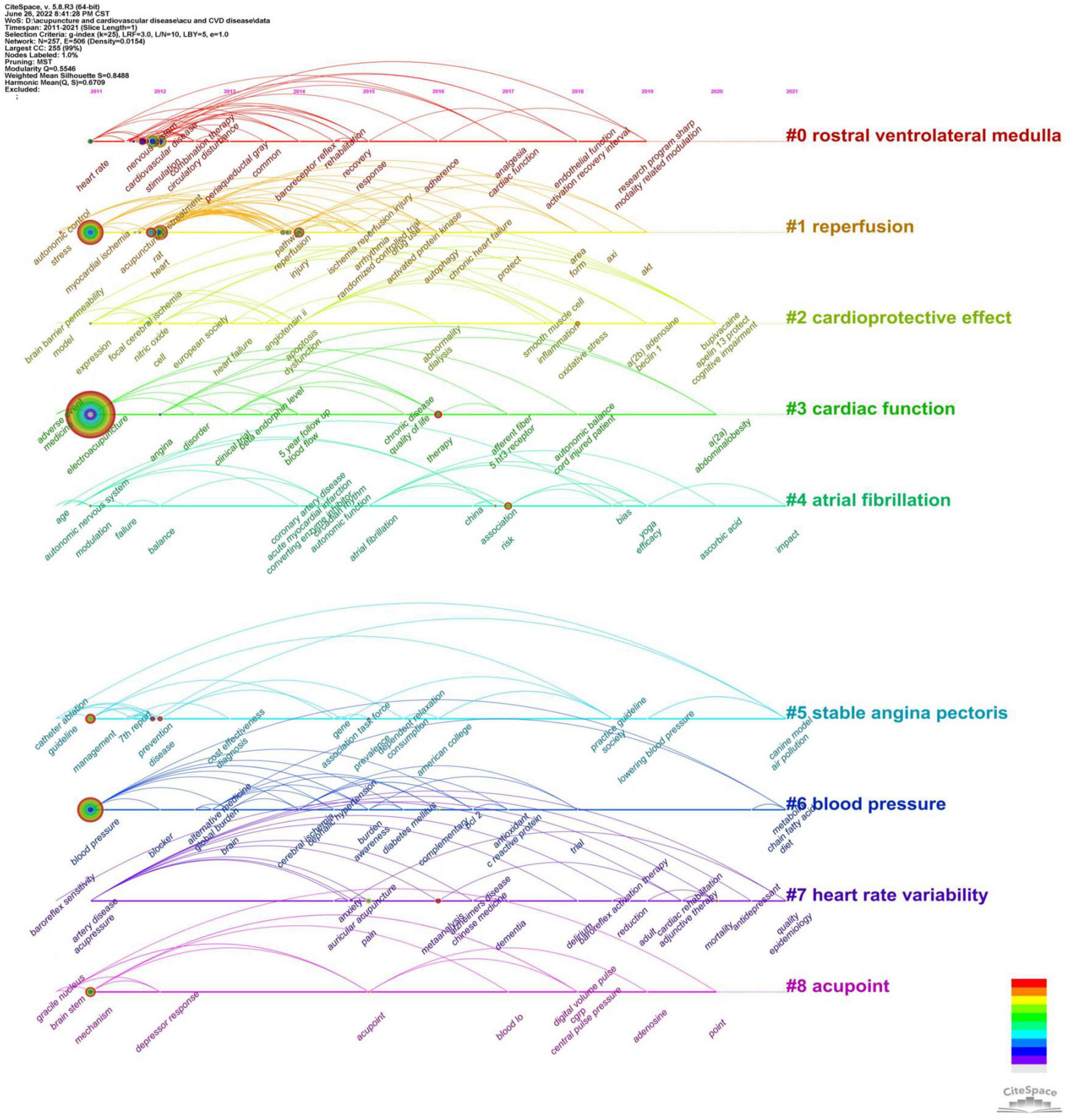
Figure 8. Timeline view of the keywords about acupuncture on cardiopathy. The top nine clusters were arranged on a horizontal timeline, and the direction of time points to the right from 2011 to 2021. The horizontal lines are timelines, with different color in each cluster. The tree rings represent occurrence of keywords, and the larger rings represent more frequency of occurrence. The camber line above the horizontal line represents the co-occurrence relationship between keywords.
Discussion
General information
Signs of prosperity have not formed, with no more than 100 publications each year from 2011 to 2021. In the past, for a long time, acupuncture was used to treat neurological diseases (including hemiplegic paralysis, facial paralysis, insomnia, and cephalalgia), orthopedic diseases (such as protrusion of the lumbar intervertebral disc, cervical spondylosis, and knee osteoarthritis), and gastrointestinal diseases (such as constipation, diarrhea, and hiccup singulation); cardiovascular diseases were not included in the spectrum of common ailments treated by acupuncture (16). Due to the characteristics of acute onset, severe condition, and high mortality of cardiovascular diseases, as a complementary and alternative therapy, the therapeutic effect of acupuncture in cardiovascular diseases has been neglected in the past. In recent years, with the development of the mechanism of acupuncture in analgesia, anti-inflammatory and nerve regulation (7–9), and effects in withdrawal syndrome (17), weight loss (18), and blood pressure regulation (19), acupuncture has become a potential therapeutic method for reducing cardiovascular disease risk factors, reducing the number of acute attacks, improving the results of electrocardiography, and alleviating anxiety and depression (20). This could explain the slow development progress of this field in the past, but the trend of steady growth augurs well for the future.
Considering the number of outputs and centrality, China and the United States are the leading countries where research on acupuncture for treating cardiopathies occurs and has maintained a certain degree of cooperation with other countries. As the birthplace of acupuncture, China accounted for 63.6% of all publications. Unfortunately, there is not much cooperation between China and the United States. Therefore, researchers and institutions from China and the United States should remove academic barriers and seek more cooperation for high-quality and in-depth studies. Network analysis of institutions’ publications can help to identify the most influential groups in this research field. The three institutions with the most publications were Beijing University of Chinese Medicine (39 publications), Chengdu University of Traditional Chinese Medicine (28 publications), and China Academy of Chinese Medical Sciences (26 publications). As shown in Figure 3, the thin connecting lines between these three nodes represent no ideal cooperation between these institutions. The lack of communication and cooperation among the most productive institutions will certainly limit development of the field. Hence, it is strongly recommended to strengthen cooperation and exchanges of research findings between institutions, reduce academic barriers, and promote the development of acupuncture for treating cardiopathies.
From the perspective of the authors, Fanrong Liang, a Chinese scholar from Chengdu University of Traditional Chinese Medicine, is the most productive, with 21 publications. Fanrong Liang’s team committed to clinical efficacy research of acupuncture for the treatment of angina pectoris. An randomized controlled trial (RCT) investigating electroacupuncture on chronic stable angina pectoris was published in JAMA Internal Medicine (IF = 20.768) (21). From the top ten productive authors, Cunzhi Liu, Yu Wang, Jingwen Yang, Guangxia Shi and Liqiong Wang all came from Beijing University of Chinese Medicine. This team from Beijing University of Chinese Medicine focused on clinical and mechanistic research of acupuncture-related therapies (electroacupuncture and transcutaneous electrical acupoint stimulation) in the treatment of hypertension (including essential hypertension and stage 1 hypertension), arrhythmia, stable angina, and myocardial ischemia.
EVID-BASED COMPL ALT was the most popular journal, with 50 publications, and ranked second in the co-cited journals, which means it plays a key role in this research field. The journal Circulation ranked first in the number of co-cited journals with a high impact factor (IF = 29.69). The average impact factor of the top ten journals was 2.07, and that of the top ten co-cited journals was 16.64. Based on support from high-quality references from leading journals around the world, higher quality articles are expected to be published in the future.
Research hotspots
Keywords summarize topics, research techniques, and core content of research. Through keyword co-occurrence analysis, keyword clusters and keyword citation bursts, we can trace the development of various hotspots in a particular field. Combined with the cluster titles in Figure 7, we summarized the following three research hotspots, in which the rostral ventrolateral medulla (RVLM) and autonomic nervous system (ANS) were the most popular mechanisms of acupuncture for treating cardiopathies.
Blood pressure regulation and mechanism
With the deepening of research on acupuncture and neuroendocrine network theory, acupuncture gradually became a new star in the regulation strategy of blood pressure. Strictly speaking, hypertension belongs to vascular illnesses among cardiovascular diseases. However, considering that chronic hypertension often leads to hypertensive heart disease, hypertension was also included in this study as a risk factor for heart disease.
Several clinical trials have proven that acupuncture therapies [including abdominal acupuncture (22), auricular acupuncture (22, 23), electroacupuncture (24), and transcutaneous electrical acupoint stimulation (25)] have therapeutic effects on multiple types of hypertension [prehypertension and mild hypertension (26, 27), renal failure-induced hypertension (28), hypertension in stroke patients (29, 30), and hypertension in perimenopausal women (19, 31)]. However, more than 5 meta-analyses suggested that, subject to a high risk of bias, undesirable sham acupuncture control and insufficient treatment and follow-up period, there was no evidence for the sustained blood pressure lowering effect of acupuncture, which is required for the long-term management of chronic hypertension (32–37). Further RCTs are expected to involve more scientific sham acupuncture devices, more rigorous methodological settings, and longer follow-up periods. The determination of the antihypertensive effect of acupuncture will provide a positive effect on the prevention and treatment of hypertensive heart disease.
Acupuncture plays a therapeutic role through a wide variety of pathways. For example, in spontaneously hypertensive rats, inhibition of sympathetic nervous system activity can lower blood pressure. Acupuncture can increase neuronal nitric oxide synthase (nNOS) expression in the arcuate nucleus (ARC) and ventrolateral periaqueductal grey (vlPAG) to inhibit the sympathetic nervous system, thereby lowering blood pressure (38). In addition, acupuncture inhibits the sympathetic nervous system via the regulation of renal sympathetic and ss-adrenergic receptor expression (39). Other mechanisms include oxidative stress (40), the contraction of vascular smooth muscle (41), the endogenous opioid system (42) and intestinal microbiota (24). In neuroimaging studies, acupuncture stimulation was related to several brain regions (43) in which the RVLM is responsible for the regulation of blood pressure and sympathetic output (44, 45). The RVLM is correlated with the antihypertensive effect of various types of hypertension (46–48), but the reflex pathway and central neurotransmitters need to be further explored. Fan et al. (46) summarized the clinical and mechanistic studies of acupuncture in the treatment of hypertension in detail (49), and the summary and reflection on the current research indicate the direction of future research.
Coronary heart disease
The therapeutic effect of acupuncture on coronary heart disease, including angina pectoris, myocardial ischemia and myocardial ischemia–reperfusion injury, is another research hotspot.
In the study of acupuncture treatment for stable angina pectoris, clinical research was the majority, and systematic reviews and meta-analyses emerged steadily. Remarkable clinical evidence came from Chengdu University of Traditional Chinese Medicine in China. A total of 404 patients with chronic stable angina pectoris were treated with acupuncture, pseudoacupuncture and conventional treatment. It was found that acupuncture at the Neiguan and Tongli acupoints could significantly reduce the frequency and severity of angina pectoris attacks (21). With the emergence of high-quality clinical evidence, acupuncture was increasingly recognized as an effective adjunct therapy of anti-angina drugs, whereas studies with adequate blinding and a valid sham control group are needed.
Myocardial ischemia has been studied extensively in animal experiments; an isoproterenol-induced myocardial ischemia model and a left anterior descending coronary artery (LAD) ligation model are commonly used. In the selection of acupuncture strategies, pre-treatment and post-treatment were both used by researchers, but no study focused on the therapeutic differences between them. PC6 (Neiguan) was the most commonly used intervention acupoint. Acupuncture has a definite effect on myocardial ischemia and ischemia–reperfusion injury, but the underlying mechanism is still unclear and disputable. For chronic myocardium ischemic injury, electroacupuncture achieved cardioprotective effects through activation of the phosphoinositide 3-kinase/Akt signaling pathway (50), regulation of the gene expression of KATP and protein kinases (51), modulation of sympathetic and parasympathetic nerve remodeling (52), and regulation of gut microbiota (53). Mechanisms of acupuncture for ischemia–reperfusion injury include but are not limited to cardiac sympathetic regulation (54), pyroptosis (55), oxidative stress (56) and macrophage polarization (57). Zhang et al. (58) summarized the mechanistic studies on acupuncture for treating myocardial ischemia–reperfusion injury before 2020 and provided a theoretical and methodological basis for further clinical applications (58).
Regulation of heart rate and variability
Heart rate variability (HRV) refers to the fluctuations between each beat of the heart and represents the body’s flexibility and adaptability to changes in the external environment. HRV is a reflection of ANS function and is considered a breakthrough to study the physiological effects of acupuncture (59, 60). The intervention methods mainly involved electroacupuncture and auricular acupuncture (27, 61–63), and research objects included women with primary dysmenorrhea (64, 65), people at high risk of stroke (66), hypertension patients (27), and atrial fibrillation patients (67). Related mechanisms include increased basal aortic sympathetic nerve activity (CSNA), vagus nerve activity, parasympathetic vagal tone and reduced sympathetic stress (27, 62). Negative results that did not support the effect of acupuncture on HRV still existed (68, 69), and thus, clinical evidence and mechanistic studies with higher quality are expected in the future. To date, there are no outstanding scholars or institutions in this small field, and there is no representative review that discusses the development process or prospects in detail.
Highlights and limitations
To the best of our knowledge, this is the first study summarizing the research progress on acupuncture in cardiopathies by bibliometric analysis, intuitively presenting contributors, collaboration networks, research hotspots, and development prospects through visualization. Future scholars can understand the development status and identify development prospects by reading this paper, and by learning about contributing scholars and institutions in this field, further cooperation and exchanges are expected to increase. In addition, the specific information of the 321 articles included in the analysis is provided in the Supplementary Material, and representative literature is also listed in the paper. Based on the above information, scholars can quickly identify high-quality studies for further research.
There are still some limitations in this study. First, subject to the limitations of data analysis in CiteSpace, we only collected literature from the WoS Core Collection Database; we did not include literature from Chinese or other English databases. Some original Chinese studies of systematic reviews and meta-analyses were not included in the scope, which had an impact on the results. The conclusion would be more persuasive when combined with other databases. In addition, given the purpose and length of the study, the specific therapeutic effect and mechanisms of acupuncture on related diseases cannot be discussed in detail.
Perspectives for future studies
First, skepticism remains about the effectiveness of acupuncture on cardiopathies, limited by many problems in designing and implementing existing trials. This is a common challenge in RCTs of acupuncture, and fortunately, scholars have focused on this issue and developed guidance for designing high-quality clinical trials, covering complete methodological recommendations (70). Therefore, future clinical studies about acupuncture on cardiopathies are expected to provide high-quality evidence for clinical practice and Medicare reimbursement decisions with rigorous methodological design. In addition, RVLM and ANS will be hotspots of mechanistic research in future studies on acupuncture in cardiopathies. The RVLM is a major node in the neural network responsible for blood pressure regulation and heart rate adjustment (71, 72). The ANS network is an important part of the cardiovascular nerve regulation system, and the heart is doubly innervated by the sympathetic and vagus nerves (73). Current studies have preliminarily confirmed the relationship between acupuncture treatment and RVLM and ANS (27, 43–45, 59, 60, 62), but the specific reflex pathways, central neurotransmitters, or biomarkers need to be further explored with brain localization technology, functional imaging technology, and neuroimaging technology.
Conclusion
Using CiteSpace for bibliometric analysis, this study can help researchers identify the research process and frontiers in acupuncture therapy on cardiopathies over the past decade, and undoubtedly lays a solid foundation for further research in this field. The three most striking frontiers are acupuncture for blood pressure regulation and hypertensive heart disease, acupuncture for coronary heart disease, and acupuncture for regulation of heart rate. It is worth noting that the RVLM and ANS have the potential to become hotspots in further studies.
Author contributions
XoL, ZY, and FYL were responsible for the concept and design. XoL, ZY, FYL, QZ, XnL, and WQ drafted the manuscript and critically revised the manuscript. XnL, WQ, and FRL approved the manuscript. All authors made a significant contribution to the work reported and approved the submitted version.
Funding
This study was supported by the National Natural Science Foundation of China (Nos. 82074556 and 82105027) and the international (regional) cooperation and ex-change program of the National Natural Science Foundation of China (No. U21A20404).
Acknowledgments
We express our appreciation to Chaomei Chen of Drexel University for developing CiteSpace. We also thank the reviewers for allowing us to make improvements to this manuscript.
Conflict of interest
The authors declare that the research was conducted in the absence of any commercial or financial relationships that could be construed as a potential conflict of interest.
Publisher’s note
All claims expressed in this article are solely those of the authors and do not necessarily represent those of their affiliated organizations, or those of the publisher, the editors and the reviewers. Any product that may be evaluated in this article, or claim that may be made by its manufacturer, is not guaranteed or endorsed by the publisher.
Supplementary material
The Supplementary Material for this article can be found online at: https://www.frontiersin.org/articles/10.3389/fcvm.2022.920491/full#supplementary-material
References
1. Mensah GA, Roth GA, Fuster V. The global burden of cardiovascular diseases and risk factors: 2020 and beyond. J Am Coll Cardiol. (2019) 74:2529–32. doi: 10.1016/j.jacc.2019.10.009
2. Jazayeri M-A, Emert MP. Sudden cardiac death: who is at risk? Med Clin N Am. (2019) 103:913–30. doi: 10.1016/j.mcna.2019.04.006
3. Al-Khatib SM, Stevenson WG, Ackerman MJ, Bryant WJ, Callans DJ, Curtis AB, et al. 2017 AHA/ACC/HRS Guideline for management of patients with ventricular arrhythmias and the prevention of sudden cardiac death: a report of the American college of cardiology/American heart association task force on clinical practice guidelines and the heart rhythm society. Circulation. (2018) 138:e272–391. doi: 10.1161/CIR.0000000000000614
4. Liu S, Li Y, Zeng X, Wang H, Yin P, Wang L, et al. Burden Of cardiovascular diseases In China, 1990-2016: findings from the 2016 Global Burden of disease study. JAMA Cardiol. (2019) 4:342–52. doi: 10.1001/jamacardio.2019.0295
5. Feng X-F, Hai J-J, Ma Y, Wang Z-Q, Tse H-F. Sudden cardiac death in mainland china: a systematic analysis. Circ Arrhythm Electrophysiol. (2018) 11:e006684. doi: 10.1161/CIRCEP.118.006684
6. Lu L, Zhang Y, Tang X, Ge S, Wen H, Zeng J, et al. Evidence on acupuncture therapies is underused in clinical practice and health policy. BMJ. (2022) 376:e067475. doi: 10.1136/bmj-2021-067475
7. Dou B, Li Y, Ma J, Xu Z, Fan W, Tian L, et al. Role of neuroimmune crosstalk in mediating the anti-inflammatory and analgesic effects of acupuncture on inflammatory pain. Front Neurosci. (2021) 15:695670. doi: 10.3389/fnins.2021.695670
8. Li N, Guo Y, Gong Y, Zhang Y, Fan W, Yao K, et al. The anti-inflammatory actions and mechanisms of acupuncture from acupoint to target organs via neuro-immune regulation. J Inflamm Res. (2021) 14:7191–224. doi: 10.2147/JIR.S341581
9. Qiao L, Guo M, Qian J, Xu B, Gu C, Yang Y. Research advances on acupuncture analgesia. Am J Chin Med. (2020) 48:245–58. doi: 10.1142/S0192415X20500135
10. Wu L, Li Y, Yu P, Li H, Ma S, Liu S, et al. The application of acupuncture in obstetrics and gynecology: a bibliometric analysis based on web of science. Ann Palliat Med. (2021) 10:3194–204. doi: 10.21037/apm-21-477
11. Zhao T, Guo J, Song Y, Chen H, Sun M, Chen L, et al. A bibliometric analysis of research trends of acupuncture therapy in the treatment of migraine from 2000 to 2020. J Pain Res. (2021) 14:1399–414. doi: 10.2147/JPR.S306594
12. Pei W, Peng R, Gu Y, Zhou X, Ruan J. Research trends of acupuncture therapy on insomnia in two decades (from 1999 to 2018):a bibliometric analysis. BMC Complement Altern Med. (2019) 19:225. doi: 10.1186/s12906-019-2606-5
13. Li R, Sun J, Hu H, Zhang Q, Sun R, Zhou S, et al. Research trends of acupuncture therapy on knee osteoarthritis from 2010 to 2019: a bibliometric analysis. J Pain Res. (2020) 13:1901–13. doi: 10.2147/JPR.S258739
14. Guo J, Pei L, Chen L, Chen H, Gu D, Xin C, et al. Research trends of acupuncture therapy on cancer over the past two decades: a bibliometric analysis. Integr Cancer Ther. (2020) 19:1534735420959442. doi: 10.1177/1534735420959442
15. Chaomei C, Morris S. Visualizing evolving networks: minimum spanning trees versus pathfinder networks. IEEE Symposium on Information Visualization 2003 (IEEE Cat. No.03TH8714). Seattle, WA: IEEE (2003).
16. Huang Q-F, Xie C, Wu H-G, Yang G, Liu J, Guo X-C, et al. [Spectrum and indications of acupuncture and moxibustion therapy based on bibliometric analysis]. Zhongguo Zhen Jiu. (2021) 41:1055–9.
17. Kim JH, Chung JY, Kwon YK, Kim KJ, Yang CH, Hahm D-H, et al. Acupuncture reduces alcohol withdrawal syndrome and c-Fos expression in rat brain. Am J Chin Med. (2005) 33:887–96. doi: 10.1142/S0192415X0500348X
18. Kim SY, Shin IS, Park YJ. Effect of acupuncture and intervention types on weight loss: a systematic review and meta-analysis. Obes Rev. (2018) 19:1585–96. doi: 10.1111/obr.12747
19. Seo B-N, Kwon O, Lee S, Kim H-S, Kang K-W, Seol IC, et al. Effects of acupuncture on lowering blood pressure in postmenopausal women with prehypertension or stage 1 hypertension: a propensity score-matched analysis. J Clin Med. (2021) 10:1426. doi: 10.3390/jcm10071426
20. Yang M, Sun M, Du T, Long H, Chen J, Liang F, et al. The efficacy of acupuncture for stable angina pectoris: a systematic review and meta-analysis. Eur J Prev Cardiol. (2021) 28:1415–25. doi: 10.1177/2047487319876761
21. Zhao L, Li D, Zheng H, Chang X, Cui J, Wang R, et al. Acupuncture as adjunctive therapy for chronic stable angina: a randomized clinical trial. JAMA Intern Med. (2019) 179:1388–97. doi: 10.1001/jamainternmed.2019.2407
22. Abdi H, Tayefi M, Moallem SR, Zhao B, Fayaz M, Ardabili HM, et al. Abdominal and auricular acupuncture reduces blood pressure in hypertensive patients. Complement Ther Med. (2017) 31:20–6. doi: 10.1016/j.ctim.2017.01.003
23. Li L, Zhang K, Shi N. Effects of the traditional Chinese auricular point therapy combined with relaxation training on patients with hypertension and anxiety. Biomed Res-India. (2017) 28:5224–8.
24. Wang J-M, Yang M-X, Wu Q-F, Chen J, Deng S-F, Chen L. Improvement of intestinal flora: accompany with the antihypertensive effect of electroacupuncture on stage 1 hypertension. Chin Med. (2021) 16:7. doi: 10.1186/s13020-020-00417-8
25. Tu J-F, Wang L-Q, Liu J-H, Qi Y-S, Tian Z-X, Wang Y, et al. Home-based transcutaneous electrical acupoint stimulation for hypertension: a randomized controlled pilot trial. Hypertens Res. (2021) 44:1300–6. doi: 10.1038/s41440-021-00702-5
26. Liu Y, Park J-E, Shin K-M, Lee M, Jung HJ, Kim A-R, et al. Acupuncture lowers blood pressure in mild hypertension patients: a randomized, controlled, assessor-blinded pilot trial. Complement Ther Med. (2015) 23:658–65. doi: 10.1016/j.ctim.2015.06.014
27. Kimura K, Kitagawa Y, Tajima F. Effects of a single session of acupuncture treatment on blood pressure and heart rate variability in patients with mild hypertension. J Altern Complement Med. (2021) 27:342–8. doi: 10.1089/acm.2020.0324
28. Oh Y-I, Yang EJ, Choi S-M, Kang C-W. The effect of electroacupuncture on insulin-like growth factor-i and oxidative stress in an animal model of renal failure-induced hypertension. Kidney Blood Press Res. (2012) 35:634–43. doi: 10.1159/000339640
29. Zheng H, Zhao X, Du Y, Shi X. Acupuncture for blood pressure control in stroke patients: case reports. Forsch Komplementarmed. (2016) 23:351–5. doi: 10.1159/000452984
30. Hong S, Ahn L, Kwon J, Choi D-J. Acupuncture for regulating blood pressure of stroke patients: a systematic review and meta-analysis. J Altern Complement Med. (2020) 26:1105–16. doi: 10.1089/acm.2019.0454
31. Palma F, Fontanesi F, Neri I, Xholli A, Facchinetti F, Cagnacci A. Blood pressure and cardiovascular risk factors in women treated for climacteric symptoms with acupuncture, phytoestrogens, or hormones. Menopause. (2020) 27:1060–5. doi: 10.1097/GME.0000000000001626
32. Yang J, Chen J, Yang M, Yu S, Ying L, Liu GJ, et al. Acupuncture for hypertension. Cochrane Database Syst Rev. (2018) 2018:CD008821. doi: 10.1002/14651858.CD008821.pub2
33. Li D-Z, Zhou Y, Yang Y-N, Ma Y-T, Li X-M, Yu J, et al. Acupuncture for essential hypertension: a meta-analysis of randomized sham-controlled clinical trials. Evid-Based Complement Altern Med. (2014) 2014:279478. doi: 10.1155/2014/279478
34. Wang J, Xiong X, Liu W. Acupuncture for essential hypertension. Int J Cardiol. (2013) 169:317–26. doi: 10.1016/j.ijcard.2013.09.001
35. Tan X, Pan Y, Su W, Gong S, Zhu H, Chen H, et al. Acupuncture therapy for essential hypertension: a network meta-analysis. Ann Transl Med. (2019) 7:266. doi: 10.21037/atm.2019.05.59
36. Zhao Z-H, Zhou Y, Li W-H, Tang Z-H, Xia T-W, Han L. Auricular acupressure in patients with hypertension and insomnia: a systematic review and meta-analysis. Evid-Based Complement Altern Med. (2020) 2020:7279486. doi: 10.1155/2020/7279486
37. Chen H, Shen F-E, Tan X-D, Jiang W-B, Gu Y-H. Efficacy and safety of acupuncture for essential hypertension: a meta-analysis. Med Sci Monit. (2018) 24:2946–69. doi: 10.12659/MSM.909995
38. Wang L, Yang N-N, Shi G-X, Wang L-Q, Li Q-Q, Yang J-W, et al. Acupuncture attenuates blood pressure via inducing the expression of nNOS. Evid-Based Complement Altern Medi. (2021) 2021:9945277. doi: 10.1155/2021/9945277
39. Yang J-W, Ye Y, Wang X-R, Li F, Xiao L-Y, Shi G-X, et al. Acupuncture attenuates renal sympathetic activity and blood pressure via beta-adrenergic receptors in spontaneously hypertensive rats. Neural Plast. (2017) 2017:8696402. doi: 10.1155/2017/8696402
40. Leung SB, Zhang H, Lau CW, Lin Z-X. Attenuation of blood pressure in spontaneously hypertensive rats by acupuncture was associated with reduction oxidative stress and improvement from endothelial dysfunction. Chin Med. (2016) 11:38. doi: 10.1186/s13020-016-0110-0
41. Yan G, Xiaojia X, Changqing G, Zhaoyang W, Qingguo L. Effect of electro-acupuncture on gene expression in heart of rats with stress-induced pre-hypertension based on gene chip technology. J Tradit Chin Med. (2015) 35:285–94. doi: 10.1016/S0254-6272(15)30099-6
42. Li M, Tjen-A-Looi SC, Guo Z-L, Longhurst JC. Electroacupuncture modulation of reflex hypertension in rats: role of cholecystokinin octapeptide. Am J Physiol-Regul Integr Comp Physiol. (2013) 305:R404–13. doi: 10.1152/ajpregu.00196.2013
43. Li J, Wang Y, He K, Peng C, Wu P, Li C, et al. Effect of acupuncture at lr3 on cerebral glucose metabolism in a rat model of hypertension: a F-18-FDG-PET study. Evid-Based Complement Altern Med. (2018) 2018:5712857. doi: 10.1155/2018/5712857
44. Li M, Tjen-A-Looi SC, Guo Z-L, Longhurst JC. Repetitive electroacupuncture attenuates cold-induced hypertension through enkephalin in the rostral ventral lateral medulla. Sci Rep. (2016) 6:35791. doi: 10.1038/srep35791
45. Wang X-R, Yang J-W, Ji C-S, Zeng X-H, Shi G-X, Fisher M, et al. Inhibition of nadph oxidase-dependent oxidative stress in the rostral ventrolateral medulla mediates the antihypertensive effects of acupuncture in spontaneously hypertensive rats. Hypertension. (2018) 71:356–65. doi: 10.1161/HYPERTENSIONAHA.117.09759
46. Fan H, Yang J-W, Huang J, Wang L, Yang N-N, Tu J-F, et al. Peroxisome proliferator-activated receptor-gamma mediates the antihypertensive effects of acupuncture in spontaneously hypertensive rats. Neuroreport. (2020) 31:952–8. doi: 10.1097/WNR.0000000000001496
47. Zhang C-R, Xia C-M, Jiang M-Y, Zhu M-X, Zhu J-M, Du D-S, et al. Repeated electroacupuncture attenuating of apelin expression and function in the rostral ventrolateral medulla in stress-induced hypertensive rats. Brain Res Bull. (2013) 97:53–62. doi: 10.1016/j.brainresbull.2013.05.013
48. Li J, Li J, Chen Z, Liang F, Wu S, Wang H. The influence of PC6 on cardiovascular disorders: a review of central neural mechanisms. Acupunct Med. (2012) 30:47–50. doi: 10.1136/acupmed-2011-010060
49. Fan H, Yang J-W, Wang L-Q, Huang J, Lin L-L, Wang Y, et al. The hypotensive role of acupuncture in hypertension: clinical study and mechanistic study. Front Aging Neurosci. (2020) 12:138. doi: 10.3389/fnagi.2020.00138
50. Yuefeng T, Haining G, Leiyong L, Jun W, Chuntao Z. Effect of electroacupuncture at Ximen (PC 4) and Hegu (LI 4) on expression of Akt in rats with myocardial ischemia-reperfusion injury. J Tradit Chin Med. (2017) 37:835–40. doi: 10.1016/S0254-6272(18)30048-7
51. Wei W, Jiquan L, Xiangyu M, Yiguo C. Effect of electronic stimulation at Neiguan (PC 6) acupoint on gene expression of adenosine triphosphate-sensitive potassium channel and protein kinases in rats with myocardial ischemia. J Tradit Chin Med. (2015) 35:577–82. doi: 10.1016/S0254-6272(15)30142-4
52. Lu S-F, Wang J-M, Yuan J, Yang W-X, Chen L-Y, Zhang T, et al. Electroacupuncture improves cardiac function and reduces infarct size by modulating cardiac autonomic remodeling in a mouse model of myocardial ischemia. Acupunct Med. (2021) 39:681–90. doi: 10.1177/09645284211009536
53. Bai H, Gu R-J, Chen L-Y, Qian Y, Yu M-L, Xu S-L, et al. Electroacupuncture interventions alleviates myocardial ischemia reperfusion injury through regulating gut microbiota in rats. Microvasc Res. (2021) 138:104235. doi: 10.1016/j.mvr.2021.104235
54. Zhou W, Ko Y, Benharash P, Yamakawa K, Patel S, Ajijola OA, et al. Cardioprotection of electroacupuncture against myocardial ischemia-reperfusion injury by modulation of cardiac norepinephrine release. Am J Physiol Heart Circ Physiol. (2012) 302:H1818–25. doi: 10.1152/ajpheart.00030.2012
55. Zhu B, Yu L, Chen D, Wang B, Sun Y, Zhai C. Electrical acupuncture moderately decreases cardiac ischemia-reperfusion injury in rats. Acupunct Electro Ther Res. (2017) 42:203–16. doi: 10.3727/036012917X15118029263201
56. Wang D, Zhang R, Zhou X, Ma S, Qin X, Wang J, et al. Electroacupuncture pre-treatment ameliorates myocardial ischaemia/reperfusion injury through regulation of cannabinoid receptor type 2. Eur Heart J Suppl. (2015) 17:F13–23. doi: 10.1093/eurheartj/suv050
57. Zhang T, Yang W-X, Wang Y-L, Yuan J, Qian Y, Sun Q-M. Electroacupuncture preconditioning attenuates acute myocardial ischemia injury through inhibiting NLRP3 inflammasome activation in mice. Life Sci. (2020) 248:117451. doi: 10.1016/j.lfs.2020.117451
58. Zhang J, Zhu L, Li H, Tang Q. Electroacupuncture pretreatment as a novel avenue to protect heart against ischemia and reperfusion injury. Evid-Based Complement Altern Med. (2020) 2020:9786482. doi: 10.1155/2020/9786482
59. Alraek T, Tan CO. Acupuncture and heart rate variability. Acupunct Med. (2011) 29:7–8. doi: 10.1136/aim.2010.003665
60. Anderson B, Nielsen A, McKee D, Jeffres A, Kligler B. Acupuncture and heart rate variability: a systems level approach to understanding mechanism. Explore. (2012) 8:99–106. doi: 10.1016/j.explore.2011.12.002
61. Kitagawa Y, Kimura K, Yoshida S. Spectral analysis of heart rate variability during trigger point acupuncture. Acupunct Med. (2014) 32:273–8. doi: 10.1136/acupmed-2013-010440
62. Armstrong K, Gokal R, Todorsky W. Neuromodulating influence of two electroacupuncture treatments on heart rate variability, stress, and vagal activity. J Altern Complement Med. (2020) 26:928–36. doi: 10.1089/acm.2019.0267
63. Kurono Y, Minagawa M, Ishigami T, Yamada A, Kakamu T, Hayano J. Acupuncture to Danzhong but not to Zhongting increases the cardiac vagal component of heart rate variability. Auton Neurosci-Basic Clin. (2011) 161:116–20. doi: 10.1016/j.autneu.2010.12.003
64. Wang Y-J, Hsu C-C, Yeh M-L, Lin J-G. Auricular acupressure to improve menstrual pain and menstrual distress and heart rate variability for primary dysmenorrhea in youth with stress. Evid-Based Complement Altern Med. (2013) 2013:138537. doi: 10.1155/2013/138537
65. Kim E, Cho J-H, Jung WS, Lee S, Pak SC. Effect of acupuncture on heart rate variability in primary dysmenorrheic women. Am J Chin Med. (2011) 39:243–9. doi: 10.1142/S0192415X11008786
66. Hyun S-H, Im J-W, Jung W-S, Cho K-H, Kim Y-S, Ko C-N, et al. Effect of ST36 acupuncture on hyperventilation-induced CO2 reactivity of the basilar and middle cerebral arteries and heart rate variability in normal subjects. Evid-Based Complement Altern Med. (2014) 2014:574986. doi: 10.1155/2014/574986
67. Ceyhan O, Tasci S, Elmali F, Dogan A. The effect of acupressure on cardiac rhythm and heart rate among patients with atrial fibrillation: the relationship between heart rate and fatigue. Altern Ther Health Med. (2019) 25:12–9.
68. Schmitt AM, Auer U, Thalhammer JG, Holler P, Mucha MC. The effect of acupuncture and electroacupuncture of pericardium 6 and heart 7 on heart rate variability. Wien Tierarztl Monatsschr. (2015) 102:263–9.
69. Wright CL, Aickin M. Improvement of menopausal symptoms with acupuncture not reflected in changes to heart rate variability. Acupunct Med. (2011) 29:32–9. doi: 10.1136/aim.2010.003053
70. Zhang YQ, Jiao RM, Witt CM, Lao L, Liu JP, Thabane L, et al. How to design high quality acupuncture trials-a consensus informed by evidence. BMJ. (2022) 376:e067476. doi: 10.1136/bmj-2021-067476
71. Guyenet PG, Stornetta RL, Souza G, Abbott SBG, Brooks VL. Neuronal networks in hypertension: recent advances. Hypertension. (2020) 76:300–11. doi: 10.1161/HYPERTENSIONAHA.120.14521
72. Guyenet PG, Stornetta RL, Holloway BB, Souza G, Abbott SBG. Rostral ventrolateral medulla and hypertension. Hypertension. (2018) 72:559–66. doi: 10.1161/HYPERTENSIONAHA.118.10921
Keywords: acupuncture, cardiopathy, cardiovascular disease, bibliometric analysis, CiteSpace
Citation: Li X, Yin Z, Ling F, Zheng Q, Li X, Qi W and Liang F (2022) The application of acupuncture in cardiopathy: A bibliometric analysis based on Web of Science across ten recent years. Front. Cardiovasc. Med. 9:920491. doi: 10.3389/fcvm.2022.920491
Received: 20 April 2022; Accepted: 12 August 2022;
Published: 06 September 2022.
Edited by:
Mansueto Gomes-Neto, Federal University of Bahia, BrazilReviewed by:
Yi-Hung Chen, China Medical University, TaiwanJianqiao Fang, Zhejiang Chinese Medical University, China
Copyright © 2022 Li, Yin, Ling, Zheng, Li, Qi and Liang. This is an open-access article distributed under the terms of the Creative Commons Attribution License (CC BY). The use, distribution or reproduction in other forums is permitted, provided the original author(s) and the copyright owner(s) are credited and that the original publication in this journal is cited, in accordance with accepted academic practice. No use, distribution or reproduction is permitted which does not comply with these terms.
*Correspondence: Xiang Li, bGl4aWFuZ0BjZHV0Y20uZWR1LmNu; Wenchuan Qi, cWl3ZW5jaHVhbjcxMEAxMjYuY29t; Fanrong Liang, YWN1cmVzZWFyY2hAMTI2LmNvbQ==
†These authors have contributed equally to this work and share first authorship
 Xiao Li
Xiao Li Zihan Yin
Zihan Yin Fayang Ling
Fayang Ling Qianhua Zheng
Qianhua Zheng Xiang Li
Xiang Li Wenchuan Qi
Wenchuan Qi Fanrong Liang
Fanrong Liang
